Weekly market wrap

Fundamentals in focus: Our take on corporate earnings, economic growth and the jobs market
Key Takeaways:
- This past week, markets digested a slew of earnings, economic and labor market data. Overall, the data, which largely looks back at the first quarter, continues to point to a U.S. economy that came into the year with solid momentum: Earnings growth has surprised to the upside, GDP growth was negative (although consumption remains relatively healthy), and the labor market has been resilient and the unemployment rate remains low.
- The key question for the economy and earnings continues to hinge on the direction of trade and tariffs. We have seen an improvement in tone from the U.S. administration on pursuing trade deals with China and other trading partners, but concrete progress is likely needed for sustained gains in markets and the broader economy.
- Overall, stock markets have rebounded nicely over the last two weeks with the S&P 500 up about 8%, as first-quarter data has held up and policymakers seem to be making progress on trade. Keep in mind that two or three pullbacks are normal in any year, especially as markets digest potentially higher inflation and softer growth. Nonetheless, we may see better sentiment heading into year-end, as the Federal Reserve likely lowers interest rates, and earnings growth looks to recover heading into 2026.
Earnings growth: Positive for Q1, but outlook is unclear
First-quarter corporate earnings season is underway, with about 70% of S&P 500 companies having reported earnings. Thus far, about 76% of companies have reported positive earnings surprises, above the 10-year average beat rate of 75%.1 Earnings growth for Q1 remains on track for 12.5% year over year, above the 11.5% expected at the end of last year.1
However, guidance for the second quarter of earnings growth has weakened, as companies point to uncertainty around the consumer and the tariff and trade backdrop. The earnings growth forecast for Q2 has fallen to 5.8%, down substantially from the 11.3% expected at the end of last year.1
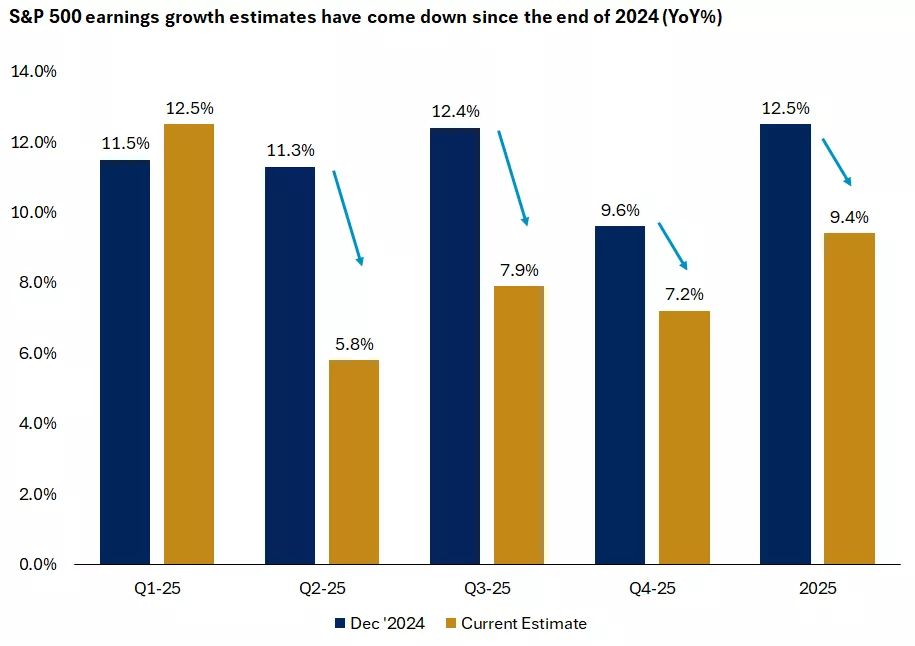
This chart shows that estimates for S&P 500 earnings per share growth in 2025 have fallen relative to expectations at the end of 2024.

This chart shows that estimates for S&P 500 earnings per share growth in 2025 have fallen relative to expectations at the end of 2024.
This past week, we heard from large-cap technology companies as well as consumer companies, which gave a good picture on the broader state of spending and the consumer. Tech giants such as Microsoft and Meta pointed to continued capital expenditure (capex) spending in artificial intelligence (AI) and datacenter growth, which was met positively given the uncertain policy backdrop. These two companies alone committed upward of $152 billion in capital expenditures to support AI capacity, which alleviated concerns of a capex slowdown.
On the other hand, companies more exposed to tariffs and consumer spending seemed to express caution. Amazon and Apple, for example, provided soft guidance and weaker sales in China, citing the tariffs and trade uncertainty as a key driver.
We also heard from consumer companies such as McDonald’s, which saw negative same-store sales and pointed to a decline in traffic. The fast-food chain joined other food service companies such as Starbucks and Chipotle, which have all pointed to softer consumer demand, particularly among low-income consumers.
Our take: Overall, earnings growth for the first quarter has remained resilient. While we may see further downward revisions to the quarters ahead, we expect earnings growth to remain in the low or mid-single-digit range for 2025 and to potentially rebound in 2026.
We have already seen meaningful downward revisions to the second quarter, as well as lowered expectations for Q3 and Q4. The expectation for corporate earnings growth for 2025 remains at about 9.5% annually.1 While this may be revised somewhat lower, historically, if earnings growth is positive, we have not experienced recessionary environments in the U.S.
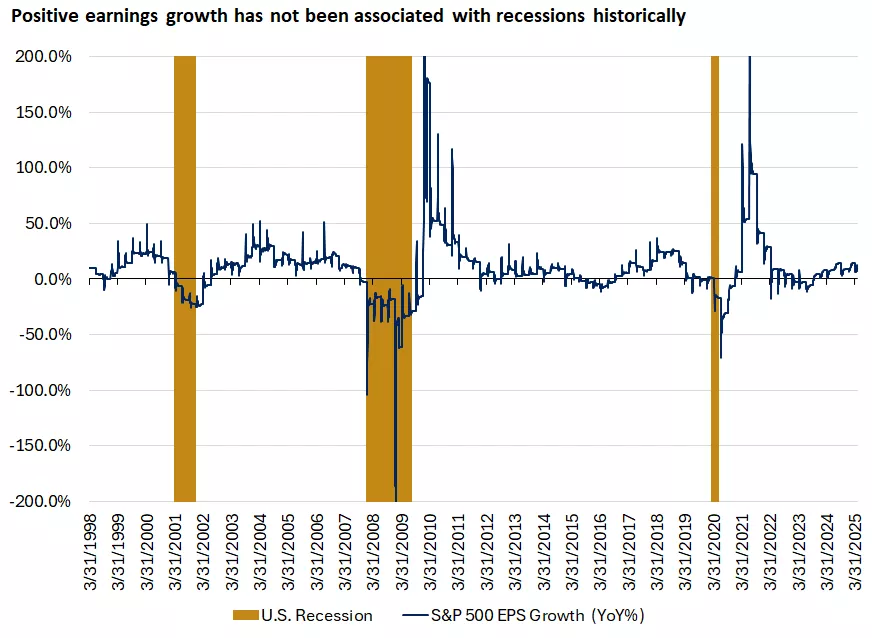
This chart shows that the year-over-year percent change in S&P 500 earnings per share has historically declined during recessionary periods.

This chart shows that the year-over-year percent change in S&P 500 earnings per share has historically declined during recessionary periods.
Economic growth: U.S. GDP growth turns negative, but recession is not the base case
First-quarter economic growth came in weaker than expected in the U.S., as gross domestic product (GDP) growth fell by -0.3% in Q1 versus an expectation of -0.2%. This was driven largely by a surge in imports — the biggest in nearly five years — as companies purchased goods in anticipation of higher tariff rates.
However, the sharp rise in imports was offset by resilient consumption and corporate investment. Personal consumption rose by 1.8% in the first quarter, down from 4% in Q4 but still above forecasts of 1.2%. Similarly, business investment climbed by 21.9%, as corporations spent on equipment ahead of potentially higher prices from tariffs.
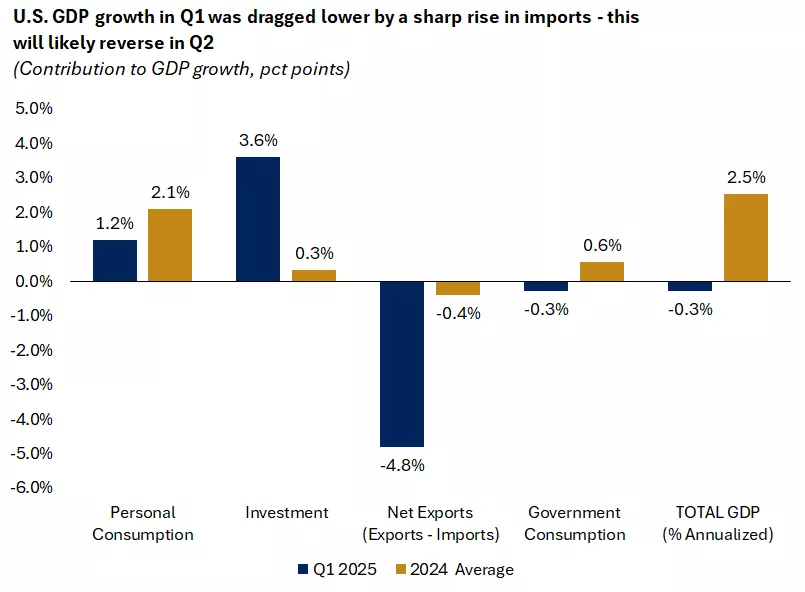
This chart shows the contribution to first-quarter real GDP growth from personal consumption, investment, net exports and government consumption. A surge in imports, which reduced net exports, was a drag on real GDP growth in the first quarter.

This chart shows the contribution to first-quarter real GDP growth from personal consumption, investment, net exports and government consumption. A surge in imports, which reduced net exports, was a drag on real GDP growth in the first quarter.
Our take: We believe the decline in first-quarter GDP will likely reverse in Q2 as the huge surge in imports reverses in the weeks ahead, bringing second-quarter GDP to a positive figure.
More broadly, we would expect U.S. GDP growth to soften this year from the 2.8% annual growth rate in 2024. In a base case — where tariffs remain around 10% or less with most trading partners, elevated in key sectors and negotiated somewhat lower with China — we would expect GDP growth to be in the 1.5% range this year.
However, there is a tail risk that tariffs remain elevated across key trading partners and particularly with China. In this case, we could see a mild recession emerge, as inflation rises and consumption cools. However, we would not expect a deep or prolonged recession, particularly as the Fed may be able to lower interest rates more meaningfully.
In either tariff scenario, growth may rebound in 2026 if the Fed is able to cut rates in the back half of 2025 and progress is made on tax reform and deregulation. This should support both consumer and corporate spending broadly.
Jobs market: Still healthy, but could slow from here
Finally, the U.S. labor market continues to show signs of resilience. The April nonfarm jobs reports released on May 2 indicated 177,000 jobs added, above the expected 138,000. While March’s figures were revised lower by 43,000, the three-month average of job gains was still healthy at around 155,000.
The unemployment rate remained steady at 4.2%, in line with expectations. Unemployment has moved gradually higher from the 2023 low of 3.4% but remains well below long-term averages of 5.7%.
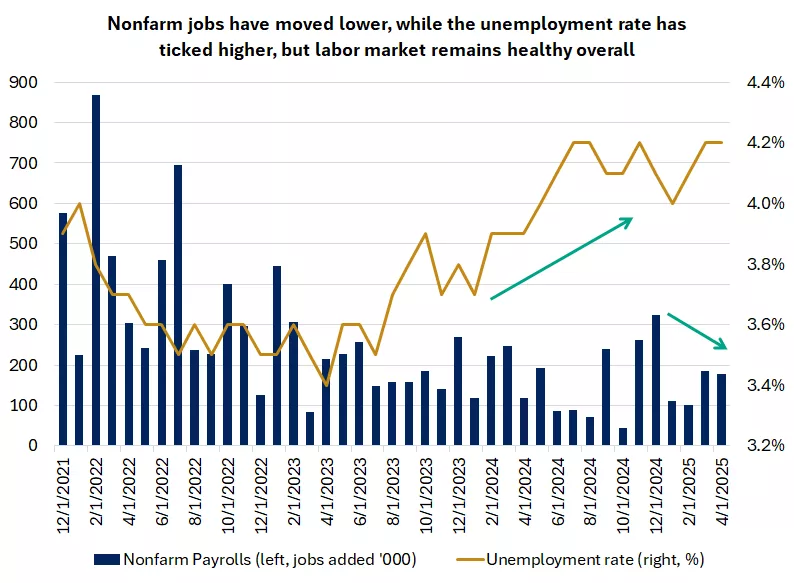
This chart shows that the unemployment rate has moved higher since 2023 while nonfarm payroll growth has slowed from the end of 2024.

This chart shows that the unemployment rate has moved higher since 2023 while nonfarm payroll growth has slowed from the end of 2024.
Also of note, the average hourly earnings rate ticked lower to 3.8% annually, below the expected 3.9%. Wage growth can be a good indicator for services inflation broadly, which may be moving lower. Wages have also outpaced inflation for nearly two years now, which means households are continuing to see positive real wages, also supportive of consumption.
Our take: While the labor market continues to show resilience, keep in mind that it tends to be a lagging indicator. If tariffs push inflation higher and the economy softens, we may see some deterioration in the labor market in the months ahead as companies increase layoffs. But given that the U.S. jobs data started from a position of strength, this should help keep the labor market orderly, even if it softens from here.
The healthy job market also likely creates less urgency for the Fed to cut interest rates. The Fed is watching inflation and the labor market closely and will be more inclined to move rates lower when it sees clearer signs of a slowdown, especially in the labor market.
While we expect the Fed to cut rates this year, this will likely happen in the back half of the year, after the impact of higher tariffs and slowing consumption has weighed more on economic growth and the jobs market.
In fact, after the resilient Friday jobs report, markets are pricing in three Fed interest rate cuts instead of four, and the probability of a June rate cut has declined from 55% to about 33%, according to the CME FedWatch Tool.
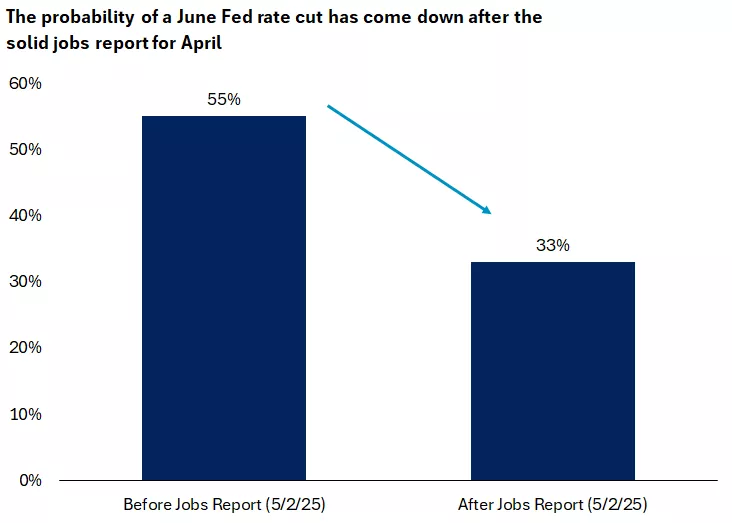
This chart shows that the probability of a Federal Reserve interest rate cut in June has declined following the better-than-expected nonfarm payrolls report for April.

This chart shows that the probability of a Federal Reserve interest rate cut in June has declined following the better-than-expected nonfarm payrolls report for April.
Remember that volatility is normal and markets are forward-looking
Overall, stock markets have rebounded nicely over the last two weeks, with the S&P 500 up about 8% and the tech-heavy Nasdaq up about 11%.1 On a year-to-date basis, the S&P 500 is now down about 3%, while the Nasdaq is down about 7%.1
The better market sentiment has been driven by solid first-quarter economic and earnings data, and the administration softening its tone on trade and tariffs. For sustainable progress from here, we would likely need to see more concrete evidence of trade deals with China and other trading partners.
Nonetheless, keep in mind that volatility is normal. In any given year, two to three pullbacks are likely — especially in a year when we have elevated uncertainty around tariffs, inflation and economic growth. However, given that we do not expect a deep or prolonged recession ahead, we continue to view periods of volatility as opportunities to rebalance, diversify or add to portfolios across sectors and asset classes.
Sectors such as financials and health care are less exposed to tariffs and may do well if policymakers make progress toward tax reform and deregulation. And within investment-grade bonds, we see value in the seven- to 10-year maturity space, especially if the Fed is poised to cut rates in the back half of the year.
While uncertainty remains elevated this year, as we look toward 2026, we could see a better backdrop emerge for financial markets. This could come from not only more concrete trade deals and details, but also a Fed that is on track with rate cuts, policymakers making progress toward tax reform and deregulation, and earnings growth that is poised to re-accelerate — all supportive of improved market sentiment.
Mona Mahajan
Investment Strategist
Source: 1. FactSet
Weekly market stats
| INDEX | CLOSE | WEEK | YTD |
|---|---|---|---|
| Dow Jones Industrial Average | 41,317 | 3.0% | -2.9% |
| S&P 500 Index | 5,687 | 2.9% | -3.3% |
| NASDAQ | 17,978 | 3.4% | -6.9% |
| MSCI EAFE* | 2,536.37 | 3.1% | 12.1% |
| 10-yr Treasury Yield | 4.31% | 0.0% | 0.4% |
| Oil ($/bbl) | $58.55 | -7.1% | -18.4% |
| Bonds | $97.95 | -0.7% | 2.9% |
Source: FactSet, 5/2/2025. Bonds represented by the iShares Core U.S. Aggregate Bond ETF. Past performance does not guarantee future results. *Morningstar Direct 5/4/2025.
The week ahead
Important economic releases this week include the FOMC meeting and ISM services PMI.
Review last week's weekly market update.
Mona Mahajan
Mona Mahajan is responsible for developing and communicating the firm's macroeconomic and financial market views. Her background includes equity and fixed income analysis, global investment strategy and portfolio management.
She regularly appears on CNBC and Bloomberg TV, and in The Wall Street Journal and Barron’s.
Mona has a master’s in business administration from Harvard Business School and bachelor's degrees in finance and computer science from the Wharton School and the School of Engineering at the University of Pennsylvania.
Important Information:
The Weekly Market Update is published every Friday, after market close.
This is for informational purposes only and should not be interpreted as specific investment advice. Investors should make investment decisions based on their unique investment objectives and financial situation. While the information is believed to be accurate, it is not guaranteed and is subject to change without notice.
Investors should understand the risks involved in owning investments, including interest rate risk, credit risk and market risk. The value of investments fluctuates and investors can lose some or all of their principal.
Past performance does not guarantee future results.
Market indexes are unmanaged and cannot be invested into directly and are not meant to depict an actual investment.
Diversification does not guarantee a profit or protect against loss in declining markets.
Systematic investing does not guarantee a profit or protect against loss. Investors should consider their willingness to keep investing when share prices are declining.
Dividends may be increased, decreased or eliminated at any time without notice.
Special risks are inherent in international investing, including those related to currency fluctuations and foreign political and economic events.
Before investing in bonds, you should understand the risks involved, including credit risk and market risk. Bond investments are also subject to interest rate risk such that when interest rates rise, the prices of bonds can decrease, and the investor can lose principal value if the investment is sold prior to maturity.
